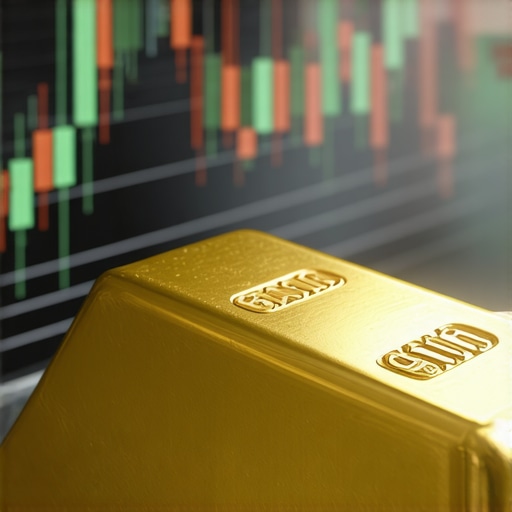Introduction to Gold Supply and Demand
Understanding the fluctuations in gold supply and demand is essential for investors, analysts, and anyone interested in the precious metals market. Gold has long been considered a safe-haven asset, a hedge against inflation, and a critical element in financial portfolios. The dynamics of supply and demand significantly influence gold prices, making it crucial to comprehend the factors that drive these changes.
The Role of Supply in the Gold Market
Gold supply primarily comes from two sources: mining and recycling. Mining activities produce new gold, while recycled gold from old jewelry and electronics contributes to the overall supply. Fluctuations in mining output can occur due to numerous factors, including geopolitical issues, environmental regulations, and technological advancements in mining practices. For instance, when major mining countries face political instability, the supply may decrease, leading to increased prices.
In addition, the gold supply chain is influenced by operational costs and the market price of gold itself. When prices rise, mining companies may increase production to capitalize on higher margins, but if prices drop, they might scale back operations, impacting supply levels.
Demand Factors Influencing Gold Prices
On the demand side, gold is sought for several purposes: investment, jewelry, and industrial applications. Investment demand, particularly from central banks and exchange-traded funds (ETFs), plays a vital role in determining gold prices. When investors seek safety during economic downturns, they flock to gold, driving prices up.
Jewelry demand, especially from countries like India and China, also significantly impacts the market. Cultural factors, seasonal demand, and economic conditions can lead to fluctuations in jewelry demand. For example, during wedding seasons or festivals, there is typically a surge in gold purchases, which can temporarily drive prices higher.
Understanding Market Trends and Fluctuations
To navigate the complexities of gold supply and demand, investors must stay informed about current market trends and analytical insights. Economic indicators, interest rates, and global events can all influence gold prices. For instance, inflation rates often correlate with increased gold demand, as investors seek to protect their wealth from eroding purchasing power.
Furthermore, understanding how gold interacts with other markets, such as stocks and currencies, is essential for strategic investment decisions. As global economies evolve, so too will the supply and demand dynamics of gold, making continuous analysis vital for anyone involved in this market.
In conclusion, understanding gold supply and demand fluctuations is critical for investors aiming to make informed decisions in a volatile market. By recognizing the underlying factors influencing these dynamics, one can better navigate the complexities of gold investments.
Gold Demand Trends in 2025: What to Expect
As we look ahead to 2025, understanding gold demand trends will be crucial for investors seeking to optimize their portfolios. Factors such as economic stability, inflation rates, and global financial policies will significantly influence the demand for gold. Investors should keep an eye on central banks’ gold purchases, as these institutions often act as major players in the gold market, adjusting their reserves based on economic forecasts.
Investment Demand: The Driving Force Behind Gold Prices
Investment demand for gold is not limited to central banks; individual and institutional investors also play a crucial role. Exchange-traded funds (ETFs) have surged in popularity, offering a liquid and accessible way to invest in gold. The benefits of gold ETFs include diversification, lower fees compared to mutual funds, and ease of trading. As more investors turn to ETFs, the overall demand for gold is expected to rise.
The Influence of Jewelry Demand on Gold Prices
Jewelry remains one of the largest sectors driving gold demand. In particular, regions like Asia, where cultural significance is attributed to gold, contribute heavily to this demand. Economic growth in countries such as India and China has led to increased consumer spending on gold jewelry. As disposable incomes rise, the demand for gold jewelry typically follows suit, impacting global gold prices.
During significant festivals and wedding seasons, the surge in jewelry purchases can lead to temporary spikes in gold prices. For instance, India’s wedding season often sees a spike in gold buying, which can have a noticeable impact on the market. Understanding these seasonal patterns is essential for investors looking to time their purchases effectively.
Industrial Applications of Gold: A Growing Sector
While investment and jewelry make up the bulk of gold demand, industrial applications are also becoming increasingly significant. Gold is used in electronics, dentistry, and even aerospace due to its excellent conductivity and resistance to corrosion. As technological advancements continue and industries expand, the demand for gold in these applications may grow, adding another layer to the supply and demand dynamics.
Global Economic Indicators and Their Impact on Gold Demand
Global economic indicators play a vital role in shaping gold demand trends. Inflation rates, interest rates, and geopolitical tensions can create uncertainty in financial markets, leading investors to seek refuge in gold. For example, during periods of high inflation, gold often performs well as a hedge against declining purchasing power. Therefore, monitoring these economic indicators is essential for investors aiming to make informed decisions in the gold market.
Conclusion: Staying Ahead of Gold Demand Trends
In conclusion, navigating gold demand trends in 2025 requires a keen understanding of various influencing factors. From investment and jewelry demand to industrial applications and economic indicators, each element plays a crucial role in shaping the future of gold prices. By staying informed and analyzing market trends, investors can position themselves strategically to capitalize on the opportunities presented by the evolving gold market.
For those eager to dive deeper, exploring resources on gold demand can provide valuable insights and help enhance investment strategies.
Factors Influencing Gold Demand Growth
As we move towards 2025, several factors are poised to impact gold demand significantly. One of the key drivers is the increasing economic instability in various regions around the globe. Investors often flock to gold as a safe haven during turbulent times, making it essential to analyze how geopolitical events and economic policies may shape market dynamics. For instance, ongoing trade disputes and political unrest can lead to heightened demand for gold, as investors seek to protect their wealth.
The Role of Central Banks in Shaping Gold Demand
Central banks play a pivotal role in the gold market, influencing both demand and supply. In recent years, many central banks have increased their gold reserves, viewing the metal as a hedge against inflation and currency fluctuations. As central banks around the world continue to diversify their holdings, the impact on gold prices can be profound. Understanding these trends can help investors anticipate market movements and adjust their strategies accordingly.
Emerging Markets: A Key Component of Gold Demand
Emerging markets, particularly in Asia, are becoming increasingly important in the global gold landscape. Countries like India and China not only have a rich cultural affinity for gold but also boast growing middle classes that are eager to invest in gold for wealth preservation and status. The rising disposable income in these nations translates to higher gold consumption, which can significantly influence global demand. Investors should pay attention to these trends, as they often reflect broader economic and cultural shifts.
Technological Advancements and Gold Demand
Technological advancements are also reshaping the gold market. The rise of gold recycling and innovative extraction methods are making gold more accessible, thereby potentially increasing supply. Moreover, advancements in electronics and renewable energy sectors, where gold is utilized for its conductive properties, could further stimulate demand. Industries are recognizing the value of gold, not just as a commodity but as a crucial material for technological development.
Investment Strategies for 2025: What to Consider
As we anticipate changes in gold demand trends, investors must refine their strategies to align with market conditions. Diversifying investments across different gold assets—such as physical gold, ETFs, and mining stocks—can mitigate risks while maximizing potential returns. For those looking to delve deeper into gold investments, exploring strategies for gold investments can provide valuable insights into how to navigate the evolving landscape effectively.
Conclusion: Preparing for Future Gold Demand Trends
In summary, understanding gold demand trends in 2025 is essential for investors aiming to capitalize on market opportunities. By keeping abreast of factors influencing demand—ranging from economic indicators to technological advancements—investors can position themselves for success. Engaging with resources that analyze these trends will enhance investment strategies and provide a competitive edge in the ever-changing gold market.
For further insights, consider examining gold demand trends to stay informed and prepared for the future.
Understanding Global Economic Indicators and Their Impact on Gold Demand
Global economic indicators play a crucial role in shaping the gold market. Factors such as inflation rates, interest rates, and currency strength influence investor behavior and gold prices. For instance, when inflation rises, the purchasing power of fiat currencies declines, prompting investors to seek gold as a hedge against inflation. Similarly, lower interest rates reduce the opportunity cost of holding gold, making it more attractive. Investors should monitor these indicators closely, as they can provide valuable insights into the timing and strategy for gold investments.
The Importance of Gold in Financial Portfolios
Gold has long been recognized as a vital asset in financial portfolios. Its unique properties, such as low correlation with other asset classes, make it an effective diversification tool. As market volatility increases, the need for secure investments becomes more pronounced. Incorporating gold into a portfolio can not only mitigate risk but also enhance overall returns. For those looking to strengthen their financial resilience, understanding how to diversify your portfolio with gold investments is essential.
Gold Market Trends: What to Watch in 2025
As we look towards 2025, several trends are expected to shape the gold market. The rise of digital gold, such as cryptocurrencies backed by gold, is gaining traction among younger investors. This innovative approach to gold investment may attract a new demographic, changing the traditional landscape of gold trading. Moreover, the increasing focus on sustainable and ethical sourcing of gold is likely to influence consumer preferences. Understanding these trends can help investors adapt their strategies for the evolving market.
Gold Demand Trends and Their Effects on Investors
It’s vital for investors to stay informed about gold demand trends. Fluctuations in demand can significantly impact prices and investment strategies. Economic conditions, consumer preferences, and geopolitical factors contribute to these trends. For instance, if emerging markets continue to show strong gold demand, this may lead to price increases, making it an opportune time to invest. To stay ahead, consider exploring gold demand trends and how they might affect your investment choices.
The Future of Gold Investments: Key Takeaways
In summary, the future of gold investments hinges on various factors, including economic indicators, market trends, and emerging technologies. Investors should remain proactive, continuously educating themselves on market dynamics and adapting their strategies accordingly. Engaging with resources that analyze these trends will provide a competitive edge in the increasingly complex gold investment landscape. By doing so, investors can position themselves for success in 2025 and beyond.
Comprehensive FAQ Section on Gold Investments
What are the main factors influencing gold prices?
The main factors influencing gold prices include global economic indicators such as inflation rates, interest rates, currency strength, and geopolitical events. When inflation rises, gold often increases in value as it is viewed as a safe haven against currency depreciation.
How can I diversify my investment portfolio with gold?
Diversifying an investment portfolio with gold can be achieved by allocating a portion of your assets to physical gold (coins or bars), gold ETFs, or gold mining stocks. This helps reduce risk as gold typically has a low correlation with other asset classes.
Why is gold considered a hedge against inflation?
Gold is considered a hedge against inflation because it retains its value over time. As inflation erodes the purchasing power of fiat currencies, investors often turn to gold as a stable store of value.
What are the risks associated with investing in gold?
The risks associated with investing in gold include price volatility, lack of income generation (as gold does not pay dividends), and potential storage and insurance costs for physical gold. Market sentiment can also heavily influence gold prices, leading to fluctuations.
How do geopolitical events affect the gold market?
Geopolitical events can significantly impact the gold market as they create uncertainty, leading investors to seek safe-haven assets like gold. Situations involving conflict, trade wars, or political instability often drive gold prices higher.
Is it better to invest in physical gold or gold stocks?
Investing in physical gold provides a tangible asset that can serve as a hedge against economic downturns, while gold stocks can offer potential for capital appreciation and dividends. The choice depends on individual investment goals and risk tolerance.
What role does demand from emerging markets play in gold prices?
Demand from emerging markets, particularly countries like China and India, plays a crucial role in gold prices. Increased consumer demand in these regions can lead to price increases, making it an important factor for investors to monitor.
How can technology impact the future of gold investments?
Technology can impact the future of gold investments through innovations like blockchain for tracking gold transactions, digital gold currencies, and new mining technologies that can lower production costs. Staying informed about these advancements can help investors identify new opportunities.
What are the benefits of gold ETFs compared to physical gold?
Gold ETFs offer benefits such as liquidity, ease of trading, and lower transaction costs compared to physical gold. They also eliminate the need for storage and insurance, making them a convenient option for many investors.
Where can I find reliable information on gold investment strategies?
Reliable information on gold investment strategies can be found on trusted financial news websites, investment blogs, and resources from financial advisors. Websites like the World Gold Council and reputable financial institutions provide valuable insights and analysis.
Authority Resources on Gold Investments
When researching gold investments, it is essential to rely on authoritative sources that provide accurate and up-to-date information. Here are some trusted websites and literature:
- World Gold Council – A leading authority on gold market trends and investment strategies.
- Investopedia – A comprehensive resource for financial education, including articles on gold investments.
- Kitco – A trusted source for precious metals news, prices, and analysis.
- Bloomberg – Provides financial news and analysis, including insights on gold markets.
- Forbes – Offers articles and resources on investment strategies, including gold-related content.
By utilizing these resources, investors can enhance their understanding of gold investment opportunities and stay current on market developments.
Conclusion: Embracing Gold Investments for a Secure Financial Future
In conclusion, gold investments present a unique opportunity for investors seeking to diversify their portfolios and protect against economic volatility. Understanding global economic indicators, market trends, and the dynamics of gold demand is essential for making informed investment decisions. As we move forward, leveraging authoritative resources and staying educated about the evolving landscape of gold investments will empower investors to navigate this complex market effectively. By doing so, individuals can confidently position themselves for success in their gold investment strategies, ensuring their financial future is secure and resilient.











The post provides a thorough breakdown of the gold supply and demand factors, especially emphasizing the role of geopolitical events and economic indicators, which I find particularly insightful. From my experience in financial advising, I’ve noticed that clients often overlook how seasonal demands, such as wedding seasons in India, can create temporary price spikes that impact investment timing. Additionally, the discussion on the importance of central banks adding gold to their reserves highlights a critical but sometimes underestimated driver of gold prices. It’s also interesting to see the growing influence of emerging technologies, particularly gold recycling and digital gold assets like ETFs, as these innovations are reshaping market accessibility and investor participation. For anyone serious about gold investments, blending physical gold with ETFs and mining stocks appears to strike a good balance between risk and liquidity. Monitoring global economic indicators like inflation and currency movements remains essential for anticipating price changes. Overall, anticipating trends such as increased demand from emerging markets and technological advancements will be crucial for navigating the gold market effectively in 2025 and beyond.